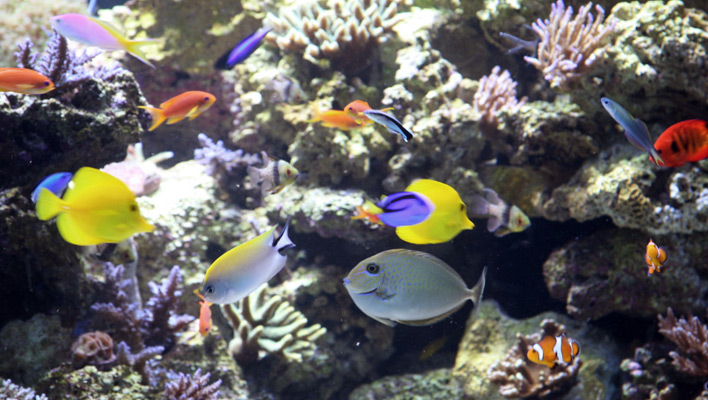Let’s face it, when a fish in our care exhibits symptoms that might suggest disease, we want to fix the problem and we want to fix it fast. What that usually means is running to the local fish store and frantically scanning the medication aisle for a product that seems to cover the condition in question and, even better, promises a quick, easy cure.
But in our haste to dose the aquarium, it’s all too easy to overlook the fact that imprudent use of aquarium medications can actually be much more harmful to fish than the maladies they’re formulated to treat—in other words, if medications aren’t used properly, the cure can be worse than the disease.
Before administering any medication to your marine aquarium fish, consider the following 7 guidelines:
#1 Rule out environmental factors first
An ammonia spike, inappropriate water chemistry or temperature, and excessive dissolved pollutants are just a few examples of environmental conditions that can cause fish to manifest physical or behavioral symptoms similar to those brought on by disease, such as:
- Rapid respiration
- Gasping at the surface
- Dashing around the tank
- Scraping on objects
- Loss of appetite
- Hiding or skulking in a corner of the tank
Before assuming a parasite or pathogen is to blame and turning to medications, you should first conduct a full range of water tests to rule out an environmental cause.
#2 Can’t ID the disease? Don’t medicate!
Effective disease treatment depends on accurate diagnosis. If you don’t know exactly what disease you’re dealing with—or you can’t at least arrive at a good educated guess—don’t risk medicating. You might just make matters worse. Ideally, you should seek the advice of a veterinarian with expertise in fish diseases (if you’re fortunate enough to have access to such an individual) or a knowledgeable, trusted dealer before selecting and administering a medication.
#3 Research the species to be treated
In addition to verifying the diagnosis, it’s vital to research the particular species of fish you intend to treat to ensure it can tolerate the particular medication you intend to use. For example, some fish, such as mandarinfish, lionfish, jawfish, clownfish, dwarf angels, and others, are intolerant of copper-based treatments to varying degrees.
#4 Always treat in a separate tank
To a certain extent, this should be a moot point because if, as recommended, you quarantine all newly acquired specimens for at least four weeks before transferring them to your display tank, the question of where to treat a sick fish should seldom arise. Still, there are times when established fish need treatment—e.g., for a bacterial infection secondary to injury. In any case, it’s always best to treat ailing specimens in a separate hospital tank.
This is true for several reasons, among them:
- It’s more economical to maintain a therapeutic level of medication in a smaller hospital tank.
- Some antibiotics and other medications can wipe out or reduce populations of beneficial nitrifying bacteria, leaving your display tank without proper biofiltration.
- Other fish or invertebrates in the display tank may not be able to tolerate the medication being administered.
- Copper-based medications (if used) tend to bind with calcareous materials—such as live rock and substrate materials—and can then leach back into the water for years to come. This is especially problematic in reef systems because corals and other invertebrates are highly sensitive to copper.
#5 Dose properly
When dosing medications, it’s important to follow the manufacturer’s instructions to the letter. Be sure to measure or calculate the exact volume of water in the system being treated so you don’t accidentally over or under dose, and never assume “If a little is good, more is better.” As any doctor will tell you, any medication can be either therapeutic or poisonous depending on how it’s used.
#6 Don’t practice polypharmacy!
Salties of a certain age will, no doubt, be familiar with the term “polypharmacy”—the use of multiple medications. Aquarium hobbyists all too often practice this when an ailing fish doesn’t appear to respond to the treatments administered. One product doesn’t seem to work, so they dose another. When that doesn’t get the desired result, in goes another, and so on.
In fish, as in people, exposure to numerous medications at once can have adverse, or even deadly, effects. If one medication isn’t doing the job, don’t switch to another without first eliminating the original drug via major water changes and, potentially, the use of activated carbon or another chemical-filtration medium.
#7 Skip the “snake oil”
Finally, be wary of proprietary formulations that claim to treat virtually every malady from ich to indigestion. Some of these products are of no more benefit than the cure-all elixirs once hawked by Nineteenth Century snake oil salesmen. If a manufacturer’s boasts sound too good to be true, you can safely assume they are.



